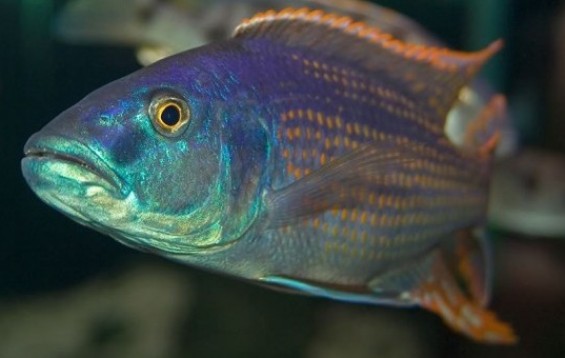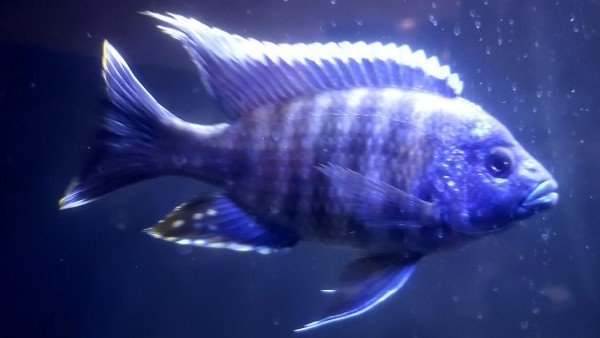- Name:
Spilo
- Family: Cichlidae
- Species: African Cichlids
- Scientific Name: Champsochromis spilorhynchus


More Details
General info about Spilo
The Spilo cichlid, also known as the Champsochromis spilorhynchus, is a species of freshwater fish in the Cichlidae family, native to Africa. These cichlids are popularly kept as pets due to their vibrant colors, relatively peaceful disposition, and ease of care. The Spilo cichlid is one of the most popular species of African cichlids, and is a great choice for any aquarium enthusiast looking for a unique and interesting fish to add to their tank. Owning a Spilo cichlid can provide a variety of benefits, including a beautiful addition to any aquarium, an interesting fish to watch and learn about, and a peaceful community fish.
The natural habitat of the Spilo cichlid is in the shallow waters of lakes, rivers, and streams in Africa. They typically inhabit areas with muddy bottoms and plenty of vegetation, and prefer temperatures between 75-79°F. The Spilo cichlid is a medium-sized cichlid, typically reaching 4-5 inches in length when fully grown. They are omnivores and feed on a variety of plant and animal matter, including worms, insect larvae, crustaceans, and vegetable matter. In addition to their diet, Spilo cichlids are known to display a variety of colors, from yellow to orange to green and blue. They can also be territorial in nature, so it is important to provide plenty of hiding places and decorations in the aquarium.
Spilo Diet & Nutrition
The Spilo cichlid is an omnivore, meaning it will eat both plant and animal matter. Appropriate food types for a Spilo cichlid include worms, insect larvae, crustaceans, and vegetable matter. It is best to provide a variety of food types, as this will help ensure that your cichlid is getting a balanced diet. Additionally, it is important to feed your cichlid small amounts several times a day, as this will help keep it healthy and avoid overfeeding. Finally, it is important to monitor your cichlid’s diet and adjust it accordingly to ensure that it is getting all the nutrients it needs.
Determining Sex of Spilo
The Spilo cichlid is a dimorphic species, meaning the males and females look different. Generally, the male is larger and more colorful, while the female is smaller and less colorful. Additionally, the male will often display aggressive behaviors, such as chasing and nipping, while the female is more likely to show signs of submissiveness. It is also worth noting that the male’s anal fin is pointed, while the female’s is rounded.
Breeding & Spawning Spilo
Before the Spilo cichlid begins to spawn, the male will display a variety of pre-spawning behaviors, such as digging in the substrate and cleaning rocks and other decorations. Additionally, the female may become more aggressive and chase away any other fish in the aquarium. Once spawning begins, the male will display a courtship dance and the female will lay her eggs on a flat rock or other surfaces. The male will then fertilize the eggs and guard them until they hatch.
Common Diseases with Spilo
The Spilo cichlid is susceptible to a variety of diseases, including Ich, Hexamita, and bacterial infections. Ich is caused by a parasite and is characterized by white spots on the body of the fish. Hexamita is a gut infection that can cause weight loss and loss of appetite. Bacterial infections can cause open sores, fin and tail rot, and cloudy eyes. Treatment options for these diseases include water changes, medication, and proper nutrition.
Spilo Origin
The Spilo cichlid is native to Africa and is found in the shallow waters of lakes, rivers, and streams. They are believed to have originated in the Congo Basin, although they are now found throughout many parts of the continent. The Spilo cichlid has been kept as a pet for many years, and is known for its vibrant colors and relatively peaceful disposition.
Caution with Spilo
The Spilo cichlid is a hardy species, but it is important to take certain precautions when keeping them in an aquarium. It is important to ensure that the water is clean and properly conditioned, as poor water quality can lead to a variety of health issues. Additionally, it is important to provide plenty of hiding places and decorations, as this will help reduce stress levels and keep the fish feeling secure.
Acclimating Spilo
When introducing a Spilo cichlid to an aquarium, it is important to take certain steps to ensure a smooth transition. Before adding the fish to the tank, make sure to acclimate it to the new environment by slowly increasing the temperature and pH levels to match those of the tank. Additionally, it is important to monitor the health of the fish closely, as any sudden changes can be a sign of stress or illness. Finally, it is important to provide plenty of hiding places and decorations, as this will help reduce stress levels and keep the fish feeling secure.
Relevent Articles
Original Detail
| Name | Species | Family | Scientific Name | More Detail | Added by |
|---|---|---|---|---|---|
| Spilo | African Cichlids | Cichlidae | Champsochromis spilorhynchus | The Spilo cichlid, also known as the Champsochromis spilorhynchus, is a species of freshwater fish in the Cichlidae family, native to Africa. These cichlids are popularly kept as pets due to their vibrant colors, relatively peaceful disposition, and ease of care. The Spilo cichlid is one of the most popular species of African cichlids, and is a great choice for any aquarium enthusiast looking for a unique and interesting fish to add to their tank. Owning a Spilo cichlid can provide a variety of benefits, including a beautiful addition to any aquarium, an interesting fish to watch and learn about, and a peaceful community fish. The natural habitat of the Spilo cichlid is in the shallow waters of lakes, rivers, and streams in Africa. They typically inhabit areas with muddy bottoms and plenty of vegetation, and prefer temperatures between 75-79°F. The Spilo cichlid is a medium-sized cichlid, typically reaching 4-5 inches in length when fully grown. They are omnivores and feed on a variety of plant and animal matter, including worms, insect larvae, crustaceans, and vegetable matter. In addition to their diet, Spilo cichlids are known to display a variety of colors, from yellow to orange to green and blue. They can also be territorial in nature, so it is important to provide plenty of hiding places and decorations in the aquarium. | PalaciosAn |
Changed by users
| Submitted Date | Submitted By | Status | Action |
|---|






